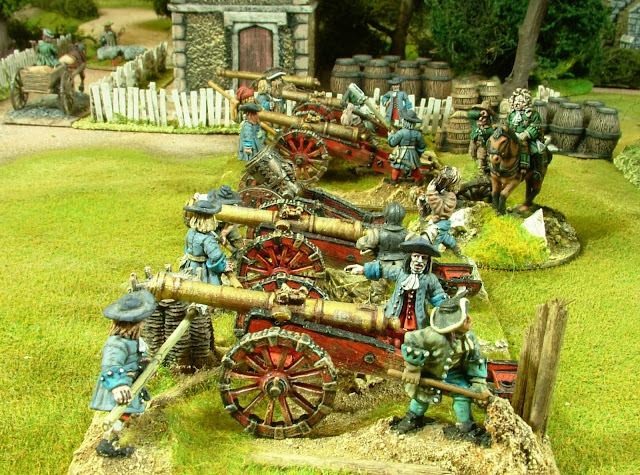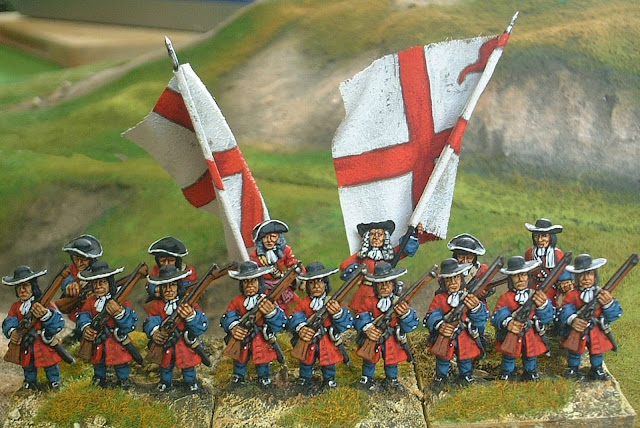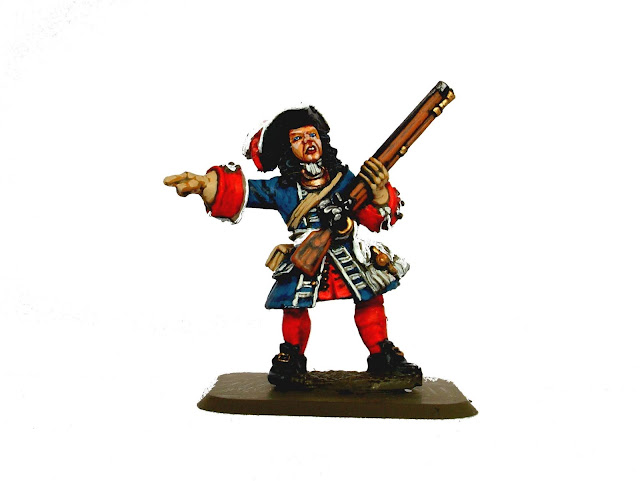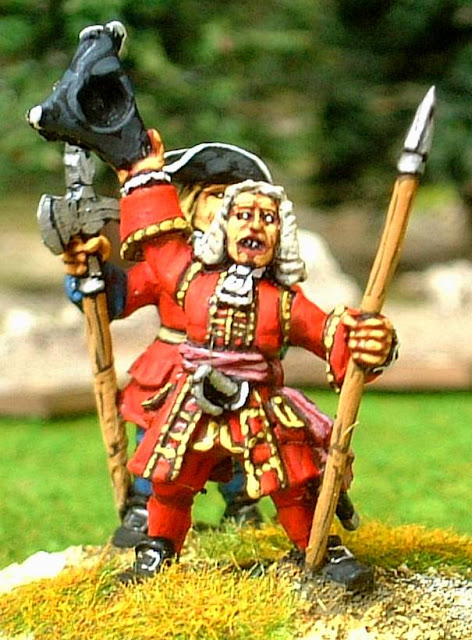| A map drawn up to wargame the action |
It does sound unmistakably like D-Day. It took place around
200 miles from and almost exactly 250 years to the day before Operation
Overlord as, although the date is now noted at June 18th the old
style calendar marks it as June 6th or 7th in most
sources. The action can be fought in various ways; as a large scale battle, as
a skirmish or even as a naval action with the troops playing no real part.
Larger scale game
Although Tollemache had as many as 10,000 men in fifteen
battalions, his spearhead was apparently a battalion of converged grenadiers
supported by 900 pike and shot armed infantry behind. This landing force can be
contained in four to six large boat models each representing a cluster of
well-boats. In each, half a battalion of infantry could be transported.
Reinforcements can be fed in using the same principle from the fleet sitting at
the table edge or off table. The Allied attack will continue as long as some
units remain unbroken on the beach or casualties are below a certain level such
as 25% of the total force (roughly four full battalions).
Players may wish to
apply slightly different criteria to the continued prosecution of the invasion
such as whether Tollemache survives or whether certain objectives are captured
such as redoubts or trench lines. By
avoiding too prescriptive a set-up, players will be able to incorporate the
vital elements necessary to make this kind of game work. It is important that
the Allied fleet gets a chance to bombard the shore defences. It is also vital
to recognize that at any given time the ships will be coming under direct fire
from up to six directions plus indirect fire from mortars they can’t even see.
It could be that the limitation on whether the attack continues or not depends
on how much damage the fleet sustains rather than casualties to the troops. In
the game damage to an off table fleet could be managed on paper.
 |
| Some of Vauban's 300 cannon |
The French entrenchments, redoubts and gun positions will be
of the very best quality having been supervised by Vauban himself. French
batteries will have interlocking fields of fire and clear lines of sight to
land and sea targets. Bearing in mind the preparations it would be unrealistic
to burden the French with any ammunition shortages but random events such as
exploding batteries or magazines are an option.
As the game may become somewhat demoralizing for the Allied
players I recommend some stepped objectives such as:
1.
Assemble two battalions on the beach at half
strength or greater. Move to next objective:-
2.
Advance towards the enemy and engage in a fire
fight or combat win or lose, Move to next objective:-
3.
Break or push back an enemy unit. Move to next
objective etc.
Reinforcements automatically landed on the beach could be a
reward for achieving some of these meaning, the game will continue and get
harder for the French player with every incremental piece of English progress.
French Troops
The total number of French forces in the Brest area probably
amounted to around the same as Tollemache’s command. The challenge could be the
same as that facing the Germans during D-Day – they are not all at the point of
decision and therefore available only in drips or not at all. Tollemache was
under the strong impression that all that opposed him was poorly armed militia
whilst the truth was far different. Vauban in a letter to the King assures him
not to be concerned as in addition to the previously mentioned artillery pieces
he had 300 bombardiers, 300 Gentlemen, 4,000 Regular infantry and a regiment of
Dragoons in place.
Fourteen squadrons of Horse under du Plessis are mentioned
in some accounts which could amount to between 700 and 1,400 men. A regiment of
Marines is stated to have manned the trenches at Camaret and been commanded by
the Marquis du Langeron. A brigade of infantry under Comte de Servon and Sieurs
de Vaise is also described as charging down on Tollemache’s beach head.
English Troops
I have attempted to identify as many as possible of the
English regiments included in the Camaret invasion force. I am fairly confident
that Richard Brewer’s, one of Thomas Erle’s two battalions and William
Stueart’s all participated. Tollemache was colonel of the Coldstream Guards and
apparently Colonel John Hope of that regiment marched from London to Plymouth
at the head of thirteen companies of English Guards on May 15th. Whether these
were from his own regiment is not clear. Two battalions of Marines are
mentioned and only two are listed for the period those of The Earl of Derby and
John, Lord Berkeley.
It is probable that both these units were with Tollemache.
I have found at least one reference to the Huguenot battalions which fought in
Ireland being included in the invasion force although other accounts have them
in Savoy at the time. If this is true we may have accounted for eight to nine
from a possible twelve to fifteen units.
The grenadier battalion is likely to have been between 300
and 600 strong. This number of men could easily come from the consolidation of
grenadier companies of twelve to fifteen regiments even if some were marines
who would have been equipped with flintlocks and worn grenadier caps similar to
army grenadiers.
 |
| English Guards were almost certainly part of the assault force. |
All of the regiments mentioned are likely to have been of
good quality with extensive combat experience with perhaps the exception of the
marines. Morale classification should therefore be Drilled or better dependant
on which rules you use. Players may wish to make the first wave Elite due to
the nature of their task.





